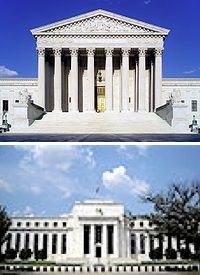
After the Supreme Court refused to hear an appeal of lower-court rulings, the Federal Reserve must release information within five days about its “emergency” bailouts of large banks and financial institutions undertaken in 2008 under the guise of saving the financial system.
The central bank attracted intense scrutiny during the economic crisis when it lent trillions of dollars to various institutions, including foreign banks, in an unprecedented transfer of wealth. And as concern intensified, several media organizations including Fox and Bloomberg sought disclosure of the bailout records using Freedom of Information Act requests.
But the Federal Reserve and a coalition of some of the biggest banks in the world fought back against disclosure for years. So after refusing to release the records, Bloomberg took the Fed to court.
The central bank argued, among other points, that the New York Fed is a private corporation with private shareholders, not a government agency subject to FOIA rules. The defendants also claimed that releasing the information would hurt the reputations of bailed-out institutions.
The Fed lost its initial case in court. It appealed and lost yet again. Finally, the central bank received a stay on the order until the case could be taken to the Supreme Court. But on March 21, the high court denied the appeal without comment, meaning the federal appeals court decision stands.
“The Federal Reserve forgot that it is the central bank for the people of the United States and not a private academy where decisions of great importance may be withheld from public scrutiny,” said Bloomberg News editor-in-chief Matthew Winkler in a statement. Meanwhile, the coalition of big banks seeking to prevent disclosure said it was “disappointed.”
Among the facts which must now be disclosed are names of bailed out institutions that took money from the Fed‘s discount window, details of the loans and more. But the prospect of having to release the information to the public has apologists of the central bank crying foul.
“The presumption is that the borrowers were to be kept private,” complained former St. Louis Fed boss William Poole. “Other loans are another matter but banks that borrow at the discount window are often presumed to be in financial trouble. That might create a run on those banks and will make banks in the future reluctant to borrow.”
The central bank has, however, reluctantly agreed to disclose the details. “The board will fully comply with the court’s decisions and is preparing to make the information available,” said a Fed spokesman cited in various news reports.
But while central bankers and their allies fumed, many analysts, Fed critics and lawmakers applauded the Supreme Court’s decision. “People wanted to know more about what the Fed was doing… It’s been a significant change and the American people won’t ever be complacent about this,” said Rep. Ron Paul (R-Texas), the chairman of the House sub-committee that deals with the Fed and monetary policy. “The Bloomberg lawsuit had a lot to do with the cultural change … Bloomberg has credibility that politicians don’t have.”
Rep. Paul, a Republican who hopes to eventually abolish the central bank and its fiat-currency system, led the charge last year to pass legislation mandating a full audit of the Fed. Most of the House of Representatives co-sponsored the measure, too.
Eventually, a significantly diluted version of the audit became law and forced the central bank to disclose some information related to more than $10 trillion the Fed provided to financial institutions. But that legislation did not cover the information set to be disclosed under the lawsuit, though discount-window details will be available in the future under the legislation after a two-year lag.
Despite having watered down the Senate “Audit the Fed” legislation approved by the House of Representatives last year, U.S. Senator Bernie Sanders of Vermont is still critical of the central bank’s policies. And he, too, celebrated the high court’s decision.
Fed boss Ben Bernanke “now must finally understand that this money doesn’t belong to the Federal Reserve, it belongs to the American people and the American people have a right to know how their taxpayer dollars are being put at risk,” Sen. Sanders told BusinessWeek. Several experts cited by the magazine supported the decision, too.
And sound-money advocates – long-time foes of the Fed and its monetary schemes – also praised the decision. The Fed will now be forced to reveal “the names of the fractional banksters to whom it gave bailouts during the financial crisis it caused,” commented Lew Rockwell, President of the Ludwig von Mises Institute.
“Now that the Fed—thanks to Mises, Rothbard, and Ron Paul—is no longer seen as just the boring name on the bills in your wallet, but as a gigantic rip-off operation to reward the State and its corporatist pals at the expense of the rest of us, its prestige has been dramatically damaged,” Rockwell wrote in a blog post. “That means it’s vulnerable. End the Fed!”
Some media analysts also applauded the decision, though reservations about whether the Fed would really comply were expressed as well. “Bloomberg correctly argues that the world’s financial system almost fell apart because of deals that had been made in secret Now Bloomberg hopes there will be transparency from the Fed, although I am afraid the central bank will look for every loophole it can find to keep its actions secret,” noted Don Bauder for the San Diego Reader.
In a follow-up response, Bauder noted: “There was a lot of unconscionable activity among the Fed, Treasury, and banks during that period. I hope this information captures it. We need to shine light on this joint public/private sector corruption.” Numerous other writers praised the Supreme Court’s action as well.
During the economic crisis that began in 2007, the Fed took unprecedented actions in a supposed effort to “rescue” the economy. Among the campaigns that aroused the most ire were the central bank’s manipulation of countless markets and the wiping out of clever investors who accurately read the market; the buying of toxic assets through front companies to prop up failing mega-banks and insurance companies like AIG; the creation of trillions of dollars out of thin air to send to foreign institutions; and much more.
The measures sparked an outcry among politicians and regular Americans, 80 percent of whom backed an audit of the central bank according to polls. Analysts complained that the actions were unconstitutional since only Congress has the authority to appropriate funds. Numerous civil and criminal complaints were filed, too.
And as the effects of the Fed’s inflation and wealth-transfer programs become more obvious, the dollar is continuing to lose its purchasing power. This has led prominent international institutions and leaders to call for the creation of a world currency and global central bank to replace the dollar’s weakening position as the international reserve currency.
The Supreme Court’s refusal to hear the case is seen as a victory for advocates of transparency at the Fed. But as the New York Times pointed out, the fact that disclosure was delayed for over two years represents a big success for the pro-secrecy central bank and its allies. Investors were not able to understand what was going on, and now that the immediate crisis seems to have faded, the information is not nearly as useful as it would have been at the time.
As the bailout details are released by the Fed in the coming days and weeks, reporters, investors and lawmakers are expected to review it carefully. How much new information will be disclosed in the thousands of pages of documents remains to be seen, but analysts are already predicting significant embarrassments for the bailed-out institutions and possibly the Fed itself.
What is certain is that the central bank is coming under increasing fire from all sides of the political spectrum. Calls to, as Rep. Paul puts it, “End the Fed,” are growing louder every day. States across America are considering legislation to restore constitutional money. And the attacks on the Fed will likely continue intensifying as the dollar decline accelerates and the people learn more about what their monetary masters have been doing behind closed doors for almost 100 years.
Photos: Supreme Court (top) and Federal Reserve Headquarters (bottom)



